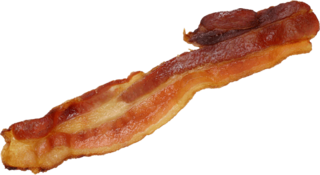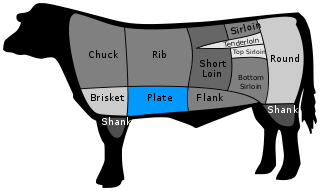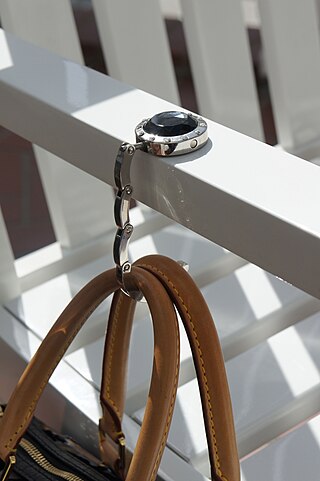
A meat hook is any hook normally used in butcheries to hang meat. This form of hook is a variation on the classic S hook.

A meat hook is any hook normally used in butcheries to hang meat. This form of hook is a variation on the classic S hook.
![]() Media related to Meat hooks at Wikimedia Commons
Media related to Meat hooks at Wikimedia Commons

Bacon is a type of salt-cured pork made from various cuts, typically the belly or less fatty parts of the back. It is eaten as a side dish, used as a central ingredient, or as a flavouring or accent.
A clothes hanger, coat hanger, or coathanger, is a hanging device in the shape/contour of:

A butcher is a person who may slaughter animals, dress their flesh, sell their meat, or participate within any combination of these three tasks. They may prepare standard cuts of meat and poultry for sale in retail or wholesale food establishments. A butcher may be employed by supermarkets, grocery stores, butcher shops and fish markets, slaughter houses, or may be self-employed.

A larder is a cool area for storing food prior to use. Originally, it was where raw meat was larded—covered in fat—to be preserved. By the 18th century, the term had expanded: at that point, a dry larder was where bread, pastry, milk, butter, or cooked meats were stored. Larders were commonplace in houses before the widespread use of the refrigerator.

A lardon, also spelled lardoon, is a small strip or cube of fatty bacon, or pork fat, used in a wide variety of cuisines to flavor savory food and salads. In French cuisine, lardons are also used for larding, by threading them with a needle into meats that are to be braised or roasted. Lardons are not normally smoked, and they are made from pork that has been cured with salt.

Figure with Meat is a 1954 painting by the Irish-born artist Francis Bacon. The figure is based on the Pope Innocent X portrait by Diego Velázquez; however, in the Bacon painting the Pope is shown as a gruesome figure and placed between two bisected halves of a cow.

A hanger steak, also known as butcher's steak or hanging tenderloin, is a cut of beef steak prized for its flavor. This cut is taken from the plate, which is the upper belly of the animal. In the past it was among several cuts of beef sometimes known as "butcher's steak", because butchers would often keep it for themselves rather than offer it for sale. This is because the general populace believed this to be a crude cut of meat, although it is actually one of the most tender.

A butcher knife or butcher's knife is a knife designed and used primarily for the butchering or dressing of animal carcasses.

Flensing is the removing of the blubber or outer integument of whales, separating it from the animal's meat. Processing the blubber into whale oil was the key step that transformed a whale carcass into a stable, transportable commodity. It was an important part of the history of whaling. The whaling that still continues in the 21st century is both industrial and aboriginal. In aboriginal whaling the blubber is rarely rendered into oil, although it may be eaten as muktuk.

Beef plate is a forequarter cut from the belly of the cow, just below the rib cut. It is typically a cheap, tough, and fatty meat. In U.K. butchery, this cut is considered part of the brisket.
A meat hook is a two-sided hook normally used in butcheries to hang up meat or the carcasses of animals such as pigs and cattle.

Crucifixion is a 1965 triptych painted by the Irish-born artist Francis Bacon. Across each of the three panels, the work shows three forms of violent death.

Pig slaughter is the work of slaughtering domestic pigs which is both a common economic activity as well as a traditional feast in some European and Asian countries.

A purse hook is a type of hook meant to temporarily secure a purse or handbag to a table, sink or armrest. Such hooks have been available since the 1920s. Queen Elizabeth II was said to employ an S-shaped one to hang her handbags on.

Speķrauši or speķa pīrādziņi, sometimes also colloquially known simply as pīrāgi or pīrādziņi, are Latvian oblong or crescent-shaped baked bread rolls or pastries filled with finely chopped fatty bacon cubes and onions. They range from five to thirteen centimetres in length, depending on if they are intended as a snack or a more substantial meal. Smaller speķrauši are often prized for their daintiness and are considered the work of a skilled cook.

Slaughtered Ox, also known as Flayed Ox, Side of Beef, or Carcass of Beef, is a 1655 oil on beech panel still life painting by Rembrandt. It has been in the collection of the Louvre in Paris since 1857. A similar painting is in Kelvingrove Art Gallery and Museum, Glasgow, possibly not created by Rembrandt himself but probably by one of his pupils, perhaps Carel Fabritius. Other similar paintings by Rembrandt or more likely his circle are held by museums in Budapest and Philadelphia.
A shoe hanger, also called a shoe display hanger, is commonly used to hang and display footwear in retail stores for the purpose of space efficient storage and to present footwear to customers. Shoe hangers have secondary functions of providing support for footwear and for displaying key information, such as style and shoe size. Shoe hangers come in a variety of styles for different display purposes and footwear types. The most common styles are wing, hook, and clip designs, which are made from plastic.

A hook is a tool consisting of a length of material, typically metal, that contains a portion that is curved or indented, such that it can be used to grab onto, connect, or otherwise attach itself onto another object. In a number of uses, one end of the hook is pointed, so that this end can pierce another material, which is then held by the curved or indented portion. Some kinds of hooks, particularly fish hooks, also have a barb, a backwards-pointed projection near the pointed end of the hook to ensure that once the hook is embedded in its target, it can not easily be removed.

Three Studies for a Crucifixion is a 1962 triptych oil painting by Francis Bacon. It was completed in March 1962 and comprises three separate canvases, each measuring 198.1 by 144.8 centimetres. The work is held by the Solomon R. Guggenheim Museum in New York.
The Butcher is an American competition reality series that airs on the History channel. In each episode, four butchers compete in a three-round elimination contest to test their butchering skills, with the overall winner receiving $10,000 and the day's championship title. The series is hosted by Colby Donaldson, with a three-judge panel consisting of David Budworth, Roxanne Spruance, and Michael Sullivan, experts in the practice of butchering. The series premiered on May 22, 2019 with a six-episode first season. The series shares a similar format to its sister-show Forged in Fire.